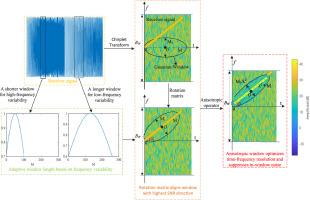基于双投影框架的时变滑动窗RLS改进水下信道跟踪
IF 3
3区 工程技术
Q2 ENGINEERING, ELECTRICAL & ELECTRONIC
引用次数: 0
摘要
递归最小二乘(RLS)算法被广泛用于信道估计,但在动态和噪声环境下,其性能下降。为了解决这个问题,我们提出了一种增强的RLS变体,时变滑动窗口RLS (TVSRLS)算法。TVSRLS算法利用小波变换提取信号的频率特征。然后根据信号频率的变化动态调整窗口长度。该算法利用旋转矩阵,将信号沿信噪比(SNR)最高的方向投影,优化对相关信号的灵敏度。使用可变窗口长度和各向异性算子,窗口形状在该方向上自适应缩放。这种方法抑制了来自其他方向的噪声,进一步提高了信噪比。该算法利用局部基函数进行二次投影,将信号映射到局部时频域。这种局部时频处理减少了残余噪声,进一步提高了信号清晰度。仿真结果表明,TVSRLS在各种噪声条件下都优于传统的滑动窗口RLS (SRLS),提供更准确的信道估计。本文章由计算机程序翻译,如有差异,请以英文原文为准。

Improved channel tracking in underwater systems using time-varying sliding window RLS with dual projection framework
The Recursive Least Squares (RLS) algorithm is widely used for channel estimation, but its performance degrades in dynamic and noisy underwater environments. To address this issue, we propose an enhanced RLS variant, the Time-Varying Sliding Window RLS (TVSRLS) algorithm. The TVSRLS algorithm extracts the signal’s frequency features using the Chirplet Transform. The window length is then dynamically adjusted based on changes in the signal’s frequency. Using a rotation matrix, the algorithm projects the signal along the direction with the highest Signal-to-Noise Ratio (SNR), optimizing sensitivity to relevant signals. The window shape is adaptively scaled in that direction using a variable window length and an anisotropic operator. This approach suppresses noise from other directions, further improving SNR. The algorithm applies a second projection using Local Basis Functions to map the signal into the local time-frequency domain. This local time-frequency processing reduces residual noise, further improving signal clarity. Simulations demonstrate that TVSRLS consistently outperforms the traditional Sliding window RLS (SRLS) in various noise conditions, providing more accurate channel estimation.
求助全文
通过发布文献求助,成功后即可免费获取论文全文。
去求助
来源期刊

Digital Signal Processing
工程技术-工程:电子与电气
CiteScore
5.30
自引率
17.20%
发文量
435
审稿时长
66 days
期刊介绍:
Digital Signal Processing: A Review Journal is one of the oldest and most established journals in the field of signal processing yet it aims to be the most innovative. The Journal invites top quality research articles at the frontiers of research in all aspects of signal processing. Our objective is to provide a platform for the publication of ground-breaking research in signal processing with both academic and industrial appeal.
The journal has a special emphasis on statistical signal processing methodology such as Bayesian signal processing, and encourages articles on emerging applications of signal processing such as:
• big data• machine learning• internet of things• information security• systems biology and computational biology,• financial time series analysis,• autonomous vehicles,• quantum computing,• neuromorphic engineering,• human-computer interaction and intelligent user interfaces,• environmental signal processing,• geophysical signal processing including seismic signal processing,• chemioinformatics and bioinformatics,• audio, visual and performance arts,• disaster management and prevention,• renewable energy,
 求助内容:
求助内容: 应助结果提醒方式:
应助结果提醒方式:


